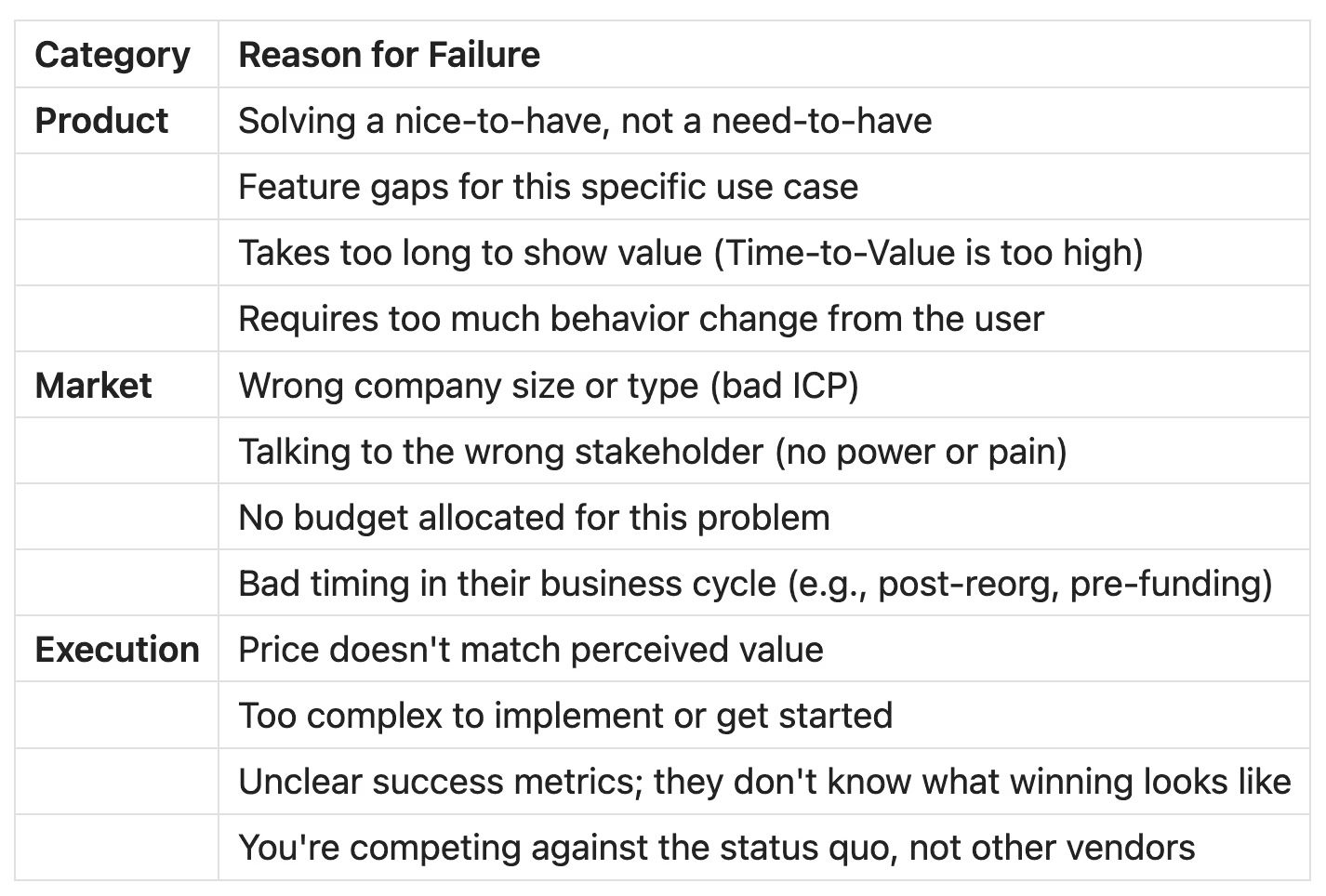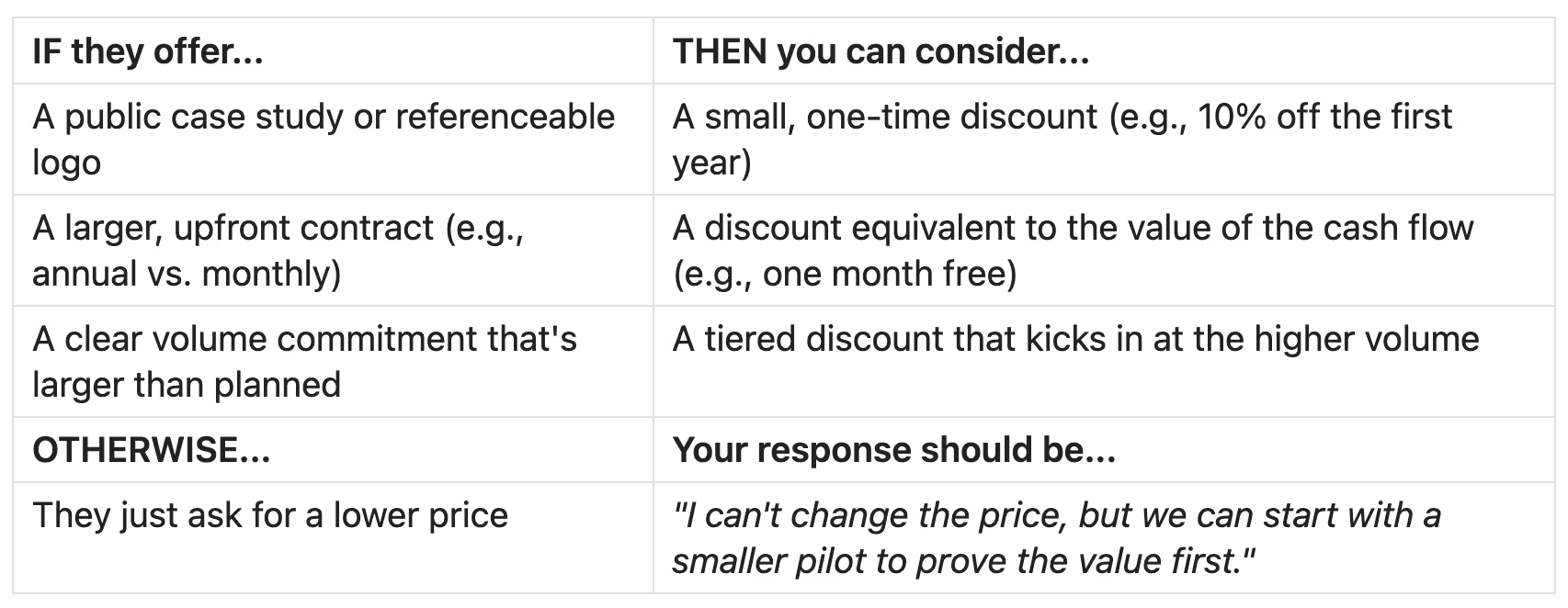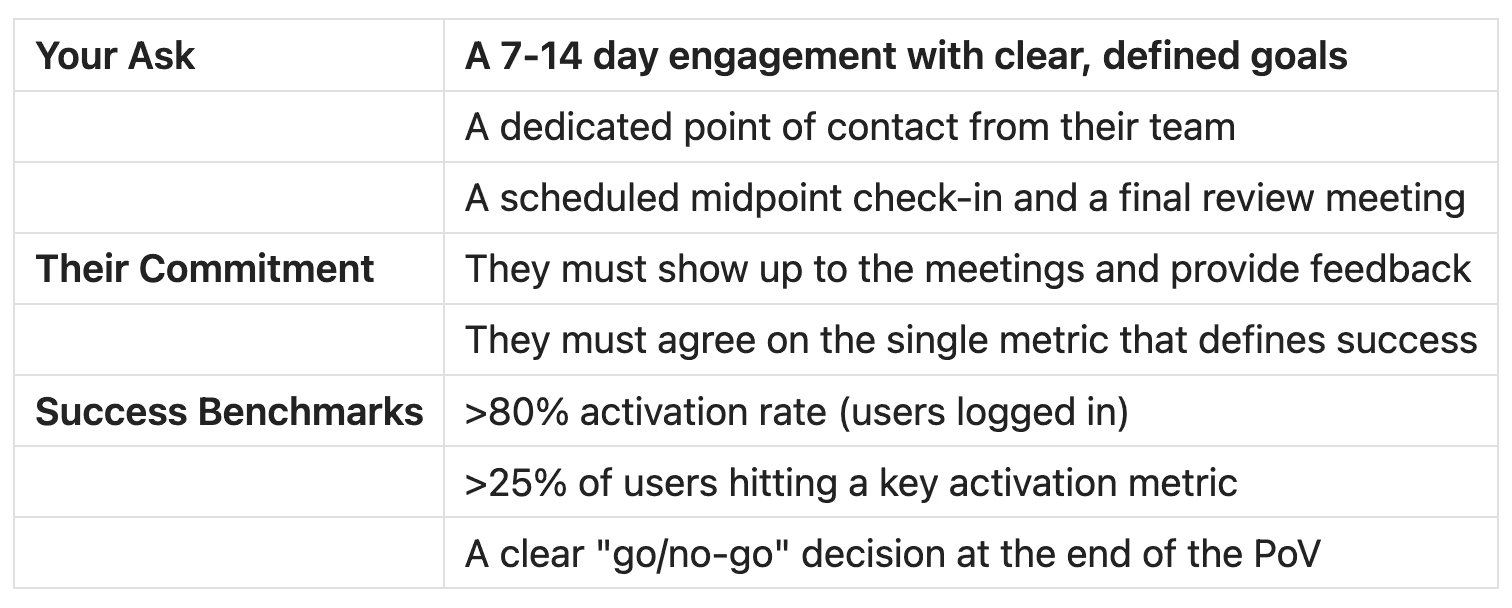
Conversation

🥳 Feedback Received!
Thanks for taking a moment to share your thoughts — it genuinely helps us make each chapter sharper.
What happens next:
- Your feedback goes straight to our product team.
- We’ll use it to refine lessons, clarify examples, and make the program even more useful.
Appreciate you helping make this program better for everyone.
Ready for your next challenge? 👇
The Simple Close & How to Get Paid
Key Idea: If you're pulling out every trick to close your first customers, something deeper is wrong. Good products with clear value don't require sales gymnastics. Your job is to make the path obvious and help them through it.
Permission Slip: You can lead a horse to water, but you can't force them to drink. If after showing clear value and following up properly, they're not buying, you might need to revisit your Foundational Five.
Outcome
By the end, you'll understand:
- Why deals actually fail (hint: it's rarely about tactics)
- The non-negotiables for every single deal
- Simple tactics that help when appropriate
- When to push for a "no" and move on with your life
Why Deals Really Don't Close
Before diving into tactics, be honest about why deals fail. It's almost always caused by a misalignment of one or more of the foundational five. Here are a couple examples outside of the Foundational Five framework (not exhaustive).

If you're consistently struggling to close, the answer isn't more tactics. It's a hard look in the mirror at these basics.
The Post-Demo North Star
Your entire job after a demo boils down to making a few things really clear. Every email, every follow-up, and every conversation should reinforce these points:
- What problem you solve, in their words
- What they get for the price (the deliverables)
- How to get started (the literal next step)
- How they'll know it's working (the success metric)
- Who your internal champion is and how you'll empower them
- How you're already adding value before they've even paid
That's it. If a deal is stalling, it's likely because one of these is fuzzy.
The Four Non-Negotiables
These are the four things you should try to do for every single opportunity.
1. Send a Same-Day Follow-Up
Within 4 hours of your call, send a follow-up email. The goal is to transfer the momentum and clarity from the call into a written artifact they can share internally. It must be clear, concise, and actionable.
- Recap the specific problem you discussed in their language
- State the path forward in a single line
- Include price and timeline
- Attach something they can easily forward, like a one-pager or a short Loom video
2. Track Everything in One Place
Even if it's just a Google Doc or a simple CRM, you need a single source of truth for your deals. Track:
- Who you talked to and when
- Their specific pain points, using their own words
- The single next action and its due date
- A pre-mortem: why might they not buy?
3. Find and Empower a Champion
You aren't selling to a company; you're selling to people within that company. One of those people needs to become your internal champion. This person believes in your solution and has the social or political capital to build consensus. Your job is to make them look like a hero.
- Identify them: Who's most excited? Who has the most to gain from your solution?
- Arm them: Help them wrap their arms around the business case, implementation, risk mitigation, etc. so they can sell internally.
- Support them: Offer to join internal calls, answer questions from their boss, and do whatever it takes to make their job easier
4. Stay Genuinely Curious & Adapt
Stop sending generic "just following up" emails. Instead, lead with genuine curiosity and adapt to their buying process. Assume the deal is moving forward and you're just there to help with the details.
- Instead of "following up," ask real questions: "You mentioned X was costing you 10 hours a week. Has that gotten worse?"
- If budget is tight, reduce the scope before you reduce the price
- If belief is low, define a short, paid pilot (a "Proof of Value") that proves one key metric, fast. Then, own the outcome
Tactical Toolbox: What to Do When...
These are tools, not magic wands. Use them when the situation calls for it, but always lead with assumptive energy, act like the deal is happening and you're just ironing out the details.
Permission Slip: It's okay if a deal stalls. It's not a reflection of your worth. Use it as a data point. Did their priorities change? Was the value not clear? Do less chasing and more learning.
...They Need Internal Buy-In
Make it really easy for your champion to sell on your behalf. Send a one-page summary with:
- The problem, in their words
- The cost of not solving it
- Your solution in one paragraph
- Price and the primary success metric
- A lightweight proof point (e.g., another customer they respect)
Pro-Tip: Proactively offer to join their internal meeting for 10 minutes to answer questions directly. It shows confidence and helps you control the narrative.
...They're Evaluating Competitors
Don't get dragged into a feature-by-feature bake-off. Instead, ask clarifying questions to re-frame the conversation around value.
- Start with: "What made you include them in your evaluation?" Then, be quiet and listen
- Follow up with: "What matters most for your team right now: getting this solved as fast as possible, having every possible feature, or getting the lowest price?"
Use their answer to anchor the rest of the conversation to your strengths.
...Momentum Stalls
- Day 1-3: "Is [Date] still good for our kickoff call? If timing has changed, just let me know what shifted."
- Day 5-7: "Feels like priorities may have shifted on your end. Should we pause this conversation, or is there something specific blocking us?"
- Day 10+: "Let's take 10 minutes to decide if this is a 'not now' or a 'not ever.' Both answers are perfectly fine; I just want to make sure we close the loop."
...They Want a Discount
Your default answer should be no. Only offer a discount in exchange for something that improves the quality of the deal for you.
Should You Offer a Discount? A Decision Framework

Prefer reducing scope (e.g., fewer seats, lower volume) over reducing your price.
...They Ask, "Can we try it for free?"
Reframe this from a "free trial" to a "Proof of Value" (PoV). They don't pay with money; they pay with attention and commitment.
The Proof of Value (PoV) Framework

Getting to No, Fast
Your goal isn't to close everyone. It's to quickly identify real opportunities and discard the rest. Push for a "no" when you see these signs:
- Three or more reschedules without a good reason
- They cannot clearly articulate the problem they're trying to solve
- You hear "I need to check with my boss" multiple times with no progress
- The energy and excitement are consistently decreasing with each interaction
When you sense this, send The Clarity Email:
Subject: Should we close this out?
Hey [Name],
It's been a few weeks since we last spoke about [Product].
Curious what's holding you back from moving forward? Is it pricing, timing, or something else?
No worries if it's just not a good time. I just don't want to waste any more of your time (or mine).
Let me know if my assumption is off.
Best,
Kevin
This email does one of three things: gets you a clean no, triggers urgency if they actually want it, or surfaces the real, hidden objection.
A Founder-Friendly Note on Legal
It's tempting to simplify your legal to make closing the deal as seamless as possible. But be forewarned, if your company starts to get traction, legal risks are a VERY real possibility. Also, early risky contracts may be a risk for future financing rounds. Check with legal and make sure you're not overly exposed.
Email Playbook: Post-Demo Frameworks
Here are some email templates to use during that delicate post-demo phase where you need to maintain momentum without being pushy. Each one is designed to add value and address a specific situation.
1. The "Honest Curiosity" Framework
Subject: Quick Ora thought
Hi {{First Name}},
Was thinking about our call - when you said "we waste hours on research" I felt that.
Genuinely curious: is the research part your biggest time sink, or is it actually the personalization?
Here's that login if you want to mess around: [credentials]
No pressure either way - just helps me understand what actually matters to you.
Kevin
2. The "Helpful Heads Up" Framework
Subject: Re: RevOps approval
Hi {{First Name}},
Hey - know you need to run this by David.
Fair warning: RevOps usually asks about API limits and data privacy. Attached answers to both.
If it helps, happy to jump on with David directly. Sometimes it's easier than playing telephone.
Let me know?
Kevin
3. The "Real Talk" Framework
Subject: Apollo comment
Hi {{First Name}},
Your Apollo comment stuck with me - "replies were terrible."
Yeah, that's everyone's experience. Mass templates pretending to be personal never work.
Look at what Sarah wrote for that CFO at Datadog: [link]
It's... actually good?
Anyway, your sandbox is there if you want to experiment.
Kevin
4. The "Not Trying to Sell You" Framework
Subject: For your leadership deck
Hi {{First Name}},
You mentioned presenting to leadership Thursday.
Made you some slides with your actual numbers - steal whatever's useful: [link]
Slide 9 has the objection handlers (the "why not just hire SDRs" question always comes up).
Good luck with it. Here if you need anything.
Kevin
5. The "Interesting Data Point" Framework
Subject: Thought you'd find this interesting
Hi {{First Name}},
Random thing - remember you asked who else uses Ora?
{{Similar Company}} just shared their week 1 numbers:
12 replies from 50 emails 3 of them asked for meetings One already converted to opportunity
They're also selling to finance. Same exact ICP as you.
Just found it interesting. Your test environment's still up if you're curious.
Kevin
6. The "No BS" Framework
Subject: Quick Q4 thought
Hi {{First Name}},
Not trying to be pushy, but realized something:
If Sarah sends 50 emails/day starting tomorrow, you'd have ~1,000 touches by October.
Even at conservative rates, that's like 15-20 meetings.
Might be worth considering for Q4 pipeline?
Totally your call - just wanted to point it out.
Kevin
7. The "Actually Solving Your Problem" Framework
Subject: Re: HubSpot duplicate issue
Hi {{First Name}},
Remember your concern about duplicate contacts?
Made you a quick video showing exactly how we handle that: [2 min Loom]
(Spoiler: we check three fields before creating anything)
Also your IT guy emailed about SOC 2 - sent it directly to him.
Let me know if other concerns pop up?
Kevin
Remember This Above All Else
If your product genuinely solves a painful problem for the right people, closing shouldn't feel like pulling teeth. You're not trying to trick people into buying something. You're trying to make it easy for people who already want their problem solved to get it solved.
The best sales process is barely a sales process at all. It's helpful project management for someone who has already decided they need what you have.
If that's not happening, don't add more tactics. Question whether you're solving a real problem for the right people.
Assignment
- Create Your Sales Artifact: Create a simple document or one-pager that houses your standard pricing, path to live, and key value propositions. Have it ready to pull up before/after every demo.
- Write Your Follow-Up Template: Using the framework above, write your standard follow-up email. Make it concise, valuable, and actionable.
- Unstall a Deal: Pick one stalled deal from your pipeline and send the "Should we close this out?" email today. If you get no response in 48 hours, move them to "Closed Lost" and move on.
- Conduct a Friction Audit: If you're experiencing consistent friction in your deals, block off 30 minutes and ask yourself the hard questions from the "Why Deals Really Don't Close" section. Be honest.
What's Next
Now that you know how to close deals and get paid, we'll move to the final section: Founder-Led Onboarding and how to reduce false positives to ensure your customers actually succeed with your product


